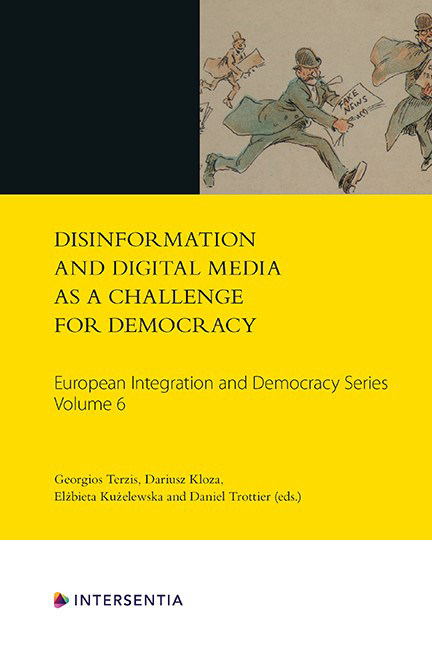Book contents
- Frontmatter
- Foreword: Fooling All of the People All of the Time: Democracy in the Age of Fake News
- Introduction: ‘They All Hear “Ping” at the Same Time’
- Contents
- List of Abbreviations
- List of Contributors
- PART I THEORETICAL APPROACHES TO AND THE CONCEPTUALISATION OF DISINFORMATION
- PART II EXPERIENCE OF DEALING WITH DISINFORMATION
- PART III SOLUTIONS TO DEAL WITH DISINFORMATION AND THEIR CRITIQUE
1 - Should We be Afraid of Fake News?
Published online by Cambridge University Press: 26 May 2021
- Frontmatter
- Foreword: Fooling All of the People All of the Time: Democracy in the Age of Fake News
- Introduction: ‘They All Hear “Ping” at the Same Time’
- Contents
- List of Abbreviations
- List of Contributors
- PART I THEORETICAL APPROACHES TO AND THE CONCEPTUALISATION OF DISINFORMATION
- PART II EXPERIENCE OF DEALING WITH DISINFORMATION
- PART III SOLUTIONS TO DEAL WITH DISINFORMATION AND THEIR CRITIQUE
Summary
INTRODUCTION
Over the past few years, ‘fake news’ has dominated public discourse, being blamed for anything from affecting electoral results to manipulating consumers, ultimately giving online social media and Internet platforms a bad name. However, I believe that there is no such thing as ‘fake news’. For the reasons explained below, I think that ‘fake news’ , a contradiction in terms, is merely a neologism, a clever catchphrase used today by politicians in order to swiftly discredit opponents and at the same time wink at their voters. The only thing different from similar phenomena in the past is the Internet and its champions, online social media platforms, that provided a suitable environment for the deployment of such ‘fake news’. However, this to me being merely an early-adoption problem that will be addressed once these new technological phenomena have been properly assimilated by society and social sciences, I believe that legislators, no matter how concerned they are in the short term, should sit this one out.
WHAT IS ‘FAKE NEWS’ EXACTLY?
According to the Cambridge Dictionary , ‘fake news’ is ‘false stories that appear to be news, spread on the Internet or using other media, usually created to influence political views or as a joke’ – in short, therefore, false stories. ‘False’ , in turn, means ‘not real, but made to look or seem real’. Thus, ultimately, ’ fake news'seems to be unreal but plausible made-up stories.
If only things were so simple. In the UK, the Digital, Culture, Media and Sport Committee of the House of Commons identified the following types of ‘fake news’ in its relevant report: fabricated content, manipulated content, imposter content, misleading content, false context of connection, satire and parody. It also added ‘micro-targeted messaging’ , before finally recommending that the term be completely abandoned and either ‘misinformation’ or ‘disinformation’ used instead. The futility of suggesting new terms to replace a globally used term aside, this is useful to demonstrate that, in fact, when we are talking about ‘fake news’ , we do not really know what we are talking about.
- Type
- Chapter
- Information
- Publisher: IntersentiaPrint publication year: 2020
- 2
- Cited by

